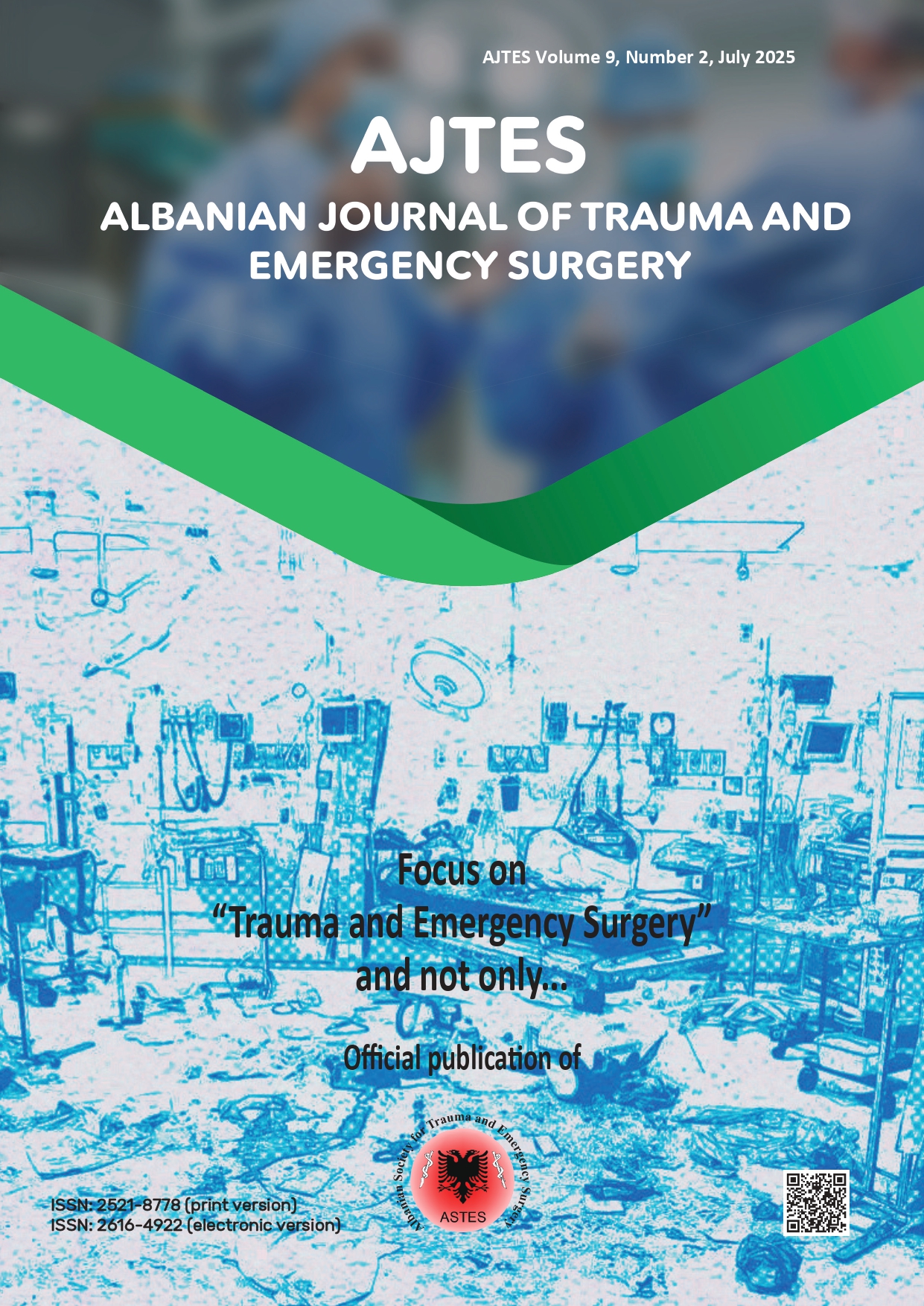Abstract
Introduction: Gunshot injuries to the thoracic cavity are relatively common and considered high risk for cardiac involvement. However, current literature shows that the incidence of cardiac damage does not differ significantly when comparing various aetiologies of penetrating chest injuries [1].
The most common predictive factors for cardiac injury include clinical manifestations, missile trajectory or anatomical wound location, and the number of chest wounds [2]. However, injuries to the heart and mediastinal vessels are often fatal and are therefore considered leading causes of death following trauma [3].
Most patients suffering from an acute traumatic cardiac injury present with hemodynamic instability and cardiac tamponade, which can subsequently lead to high mortality rates [4, 5]. Therefore, a patient with a gunshot thoracic injury, especially transmediastinal, who is hemodynamically stable and shows no clinical signs or symptoms of cardiac injury, may have underlying injuries.
We present a rare case of a stable gunshot trans -mediastinal wound patient, with initial retained haemothorax after thoracentesis, and finally diagnosed with partial heart herniation.
Conclusions: Partial heart herniation following a transmediastinal gunshot wound is a rare and potentially life-threatening condition that may present without classic signs of cardiac injury. This case emphasizes the importance of maintaining a high index of suspicion for occult cardiac trauma in hemodynamically stable patients with thoracic gunshot injuries. Timely imaging, thorough evaluation, and minimally invasive surgical exploration, such as VATS, can play a critical role in diagnosing and managing such atypical presentations, ultimately improving outcomes.
References
Kim, J. S., Inaba, K., de Leon, L. A., Rais, C., Holcomb, J. B., David, J. S., Starnes, V. A., & Demetriades, D. (2020). Penetrating injury to the cardiac box. The journal of trauma and acute care surgery, 89(3), 482–487. https://doi.org/10.1097/TA.0000000000002808
Seamon, M. J., Shiroff, A. M., Franco, M., Stawicki, S. P., Molina, E. J., Gaughan, J. P., Reilly, P. M., Schwab, C. W., Pryor, J. P., & Goldberg, A. J. (2009). Emergency department thoracotomy for penetrating injuries of the heart and great vessels: an appraisal of 283 consecutive cases from two urban trauma centers. The Journal of Trauma, 67(6), 1250–1258. https://doi.org/10.1097/TA.0b013e3181c3fef9
Rosenthal, M. A., & Ellis, J. I. (1995). Cardiac and mediastinal trauma. Emergency medicine clinics of North America, 13(4), 887–902.PMID: 7588194.
Nagy, K. K., Roberts, R. R., Smith, R. F., Joseph, K. T., An, G. C., Bokhari, F., & Barrett, J. (2002). Trans-mediastinal gunshot wounds: are "stable" patients really stable?. World journal of surgery, 26(10), 1247–1250. https://doi.org/10.1007/s00268-002-6522-2
Burack, J. H., Kandil, E., Sawas, A., O'Neill, P. A., Sclafani, S. J., Lowery, R. C., & Zenilman, M. E. (2007). Triage and outcome of patients with mediastinal penetrating trauma. The Annals of thoracic surgery, 83(2), 377–382. https://doi.org/10.1016/j.athoracsur.2006.05.107
Mandal, A. K., & Sanusi, M. (2001). Penetrating chest wounds: 24 years experience. World journal of surgery, 25(9), 1145–1149. https://doi.org/10.1007/BF03215862
Bellister, S. A., Dennis, B. M., & Guillamondegui, O. D. (2017). Blunt and Penetrating Cardiac Trauma. The Surgical clinics of North America, 97(5), 1065–1076. https://doi.org/10.1016/j.suc.2017.06.012
Branch, C. F., & Adams, J. (2012). Left ventricular rupture with resulting cardiac tamponade due to blast force trauma from gunshot wound. The Journal of emergency medicine, 43(2), 263–265. https://doi.org/10.1016/j.jemermed.2009.08.024
Rupprecht, H., & Gaab, K. (2018). Delayed Cardiac Rupture Induced by Traumatic Myocardial Infarction: Consequence of a 45-Magnum Blast Injury; A Comprehensive Case Review. Bulletin of emergency and trauma, 6(1), 1–7. https://doi.org/10.29252/beat-060101
Pooniya, S., Behera, C., Mridha, A. R., & Swain, R. (2016). Cardiac rupture delayed for a week in an asymptomatic child following blunt trauma. Medicine, science, and the law, 56(3), 217–220. https://doi.org/10.1177/0025802414562500
Kong, V. Y., Oosthuizen, G., Sartorius, B., Bruce, J., & Clarke, D. L. (2015). Penetrating cardiac injuries and the evolving management algorithm in the current era. The Journal of surgical research, 193(2), 926–932. https://doi.org/10.1016/j.jss.2014.09.027
Thomas, P., Saux, P., Lonjon, T., Viggiano, M., Denis, J. P., Giudicelli, R., Ragni, J., Gouin, F., & Fuentes, P. (1995). Diagnosis by video-assisted thoracoscopy of traumatic pericardial rupture with delayed luxation of the heart: case report. The Journal of trauma, 38(6), 967–970. https://doi.org/10.1097/00005373-199506000-00030
Poletti PA, Platon A, Shanmuganathan K, Didier D, Kalangos A, Terrier F. Asymptomatic traumatic pericardial rupture with partial right atrial herniation: case report. J Trauma. 2005; 58(5):1068-72.

This work is licensed under a Creative Commons Attribution-NonCommercial 4.0 International License.

